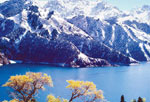Society
Scientists set to study Pacific rim earthquake risks
Updated: 2011-05-05 13:40
(Xinhua)
WELLINGTON - Portable seismographs will be installed at 900 locations in New Zealand's lower North Island as part of a study to help scientists better understand earthquake hazards in the Pacific region.
The miniature quake recorders will be buried at regular intervals, some just 100 meters apart, in a 100-km line and scientists will then detonate explosives in deep bore holes to measure the sound waves being reflected back from rock interfaces deep underground.
| ||||
The study will focus on the boundary between the Pacific and Australian tectonic plates that lie just 20 to 30 km beneath the southern North Island.
Professor Tim Stern, from Victoria's Institute of Geophysics, said the project was one of the largest of its kind to be carried out in New Zealand.
"The seismographs will tell us about the thickness and mechanical state of rock units beneath the seismic line down to depths of 50 kilometers or more," he said.
The data would help build a high resolution three-dimensional image of the rock structures and the tectonic plate boundary in the region.
The project will be one of the biggest temporary deployments of seismic equipment in New Zealand's history. It will also be the first time the boundary zone of the two tectonic plates under the region around New Zealand's capital, Wellington, has been studied in such detail.
Stern said while the Pacific plate, to the east of the North Island, was being forced under the Australian plate, they were not sliding past each other uniformly.
"In places, including under Wellington, they seem to be locked together and moving together and consequently storing a significant amount of energy."
Previous research around the Pacific Rim showed that details on the shape of plate boundaries and the character of seismic reflections from a boundary zone can provide clues about the stability of the interface and the ability of one plate to slide freely under the other.
The seismographs being used are small, light and have a maximum battery life of seven days, making timing a crucial issue.
Teams of scientists and students from Victoria's Institute of Geophysics, GNS Science and the universities of Tokyo and Southern California will spend two days deploying the recorders, which will then be left to record the blasts over three to four days.
Results of the project are expected by the end of the year.
Specials

Bin Laden dead
The world's most wanted man was killed in a US raid in Pakistan.

British Royal Wedding
Prince William and Kate Middleton married at Westminster Abbey in a royal occasion of dazzling pomp and pageantry.
Best wishes

The final frontier
Xinjiang is a mysterious land of extremes that never falls to fascinate.



